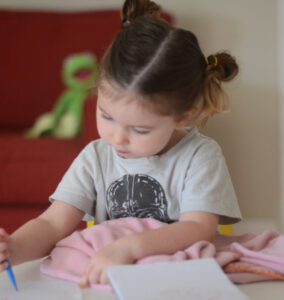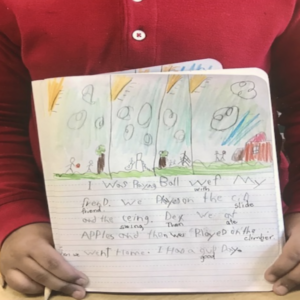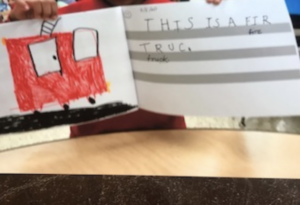
Getting Started with Writing
This collection offers manageable and fun ways to think about writing that give your class something to do together (an experience or exploration) while providing structured writing practice. In this overview, we offer a sense of how this helps young writers grow. Then we offer four cycles of exploration and writing for you to try out as part of this collection. You can do these activities with students in order to give them something to learn and talk and write about.
For our youngest writers, the scribbles and squiggles are all approximations on the way to writing; and just as we celebrate baby talk as an approximation of adult language, we want to celebrate all the steps children take on the way to becoming a full-fledged adult writer. In fact, research has shown that writing emerges very early and is distinct from other kinds of art young children make.
Building on the work of our colleagues—Eileen G. Feldgus and Isabell Cardonick, authors along with Richard Gentry, of the book Kid Writing in the 21st Century: a Systematic Approach to Phonics, Spelling, and Writing Workshop—this collection shares four simple ideas to support students in writing about the things they know about. To give you a view of what we are aiming at, we share this video of an elementary school principal in Philadelphia talking about why this program has been powerful for young writers in his school:
Basically, there are four components or steps to kid writing.
#1 Draw Your Story/Draw Your Information
Beginning writers are learning to communicate what interests them or is important to them. Drawing is a great way for them to do that. A child who draws their story or information can use that drawing to tell you what they want to write. The drawing can help a child remember what they want to say as they struggle to hold onto the letters that make up each word and all the words in the sentence(s) they want to write. Looking at the child’s drawing is a great place for adults to guide their part of the work. A teacher might ask “tell me more about this?” or “what about this part of what you drew? What is happening here?”

#2 Kid Writing
Here kids write their story, which for very beginning writers might be a single word or a single sentence. We like to take away the pressure of perfection in order to create more room for learning, so we tell young writers that kid writing is different from adult writing, and we give them room to sound out, spell words incorrectly, and even to use a “magic line” to hold the place of a word they can’t figure out how to spell. A teacher or other adult might sit side-by-side with a child during kid writing, to help them remember the whole sentence they are trying to write (what’s the next word?) or to help them sound out a word (Let’s stretch that out, what sound do you hear next?). We would encourage you to let the child lead the kid writing and not to worry about mistakes, but instead to notice what your young writer can do, and to praise it (I see you wrote your name here, great work. I noticed that you heard the “b” in “bug”, nice!).
#3 Adult Writing
After a student writes their story or information, you can write the full story for them so they can see all the words and sentences. Rather than correct the child’s writing as they go, or cross out or write over their mistakes, adult writing can just exist as another layer of the work. This page highlights some pictures of children’s work that shows their drawing, their kid writing, and the adult writing that was added.

#4 Sharing!
Writing is a form of expression, meant to be shared. We believe students should have opportunities to share their writing in class, and encourage teachers to help students think about who else might be an appreciative audience for their writing? Could they share it with their home family? A friend? A grandparent? We hope to meet stories with more stories or appreciation.
We invite you to explore the four writing cycles in this collection. Each includes noticing, drawing, and writing.

